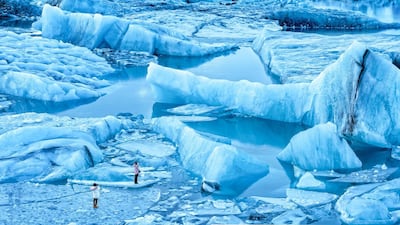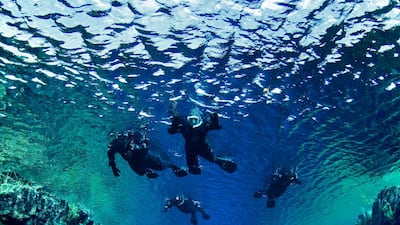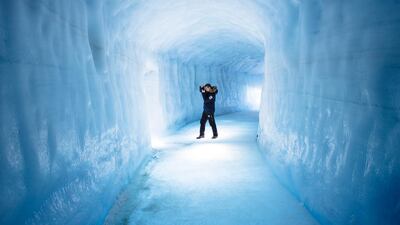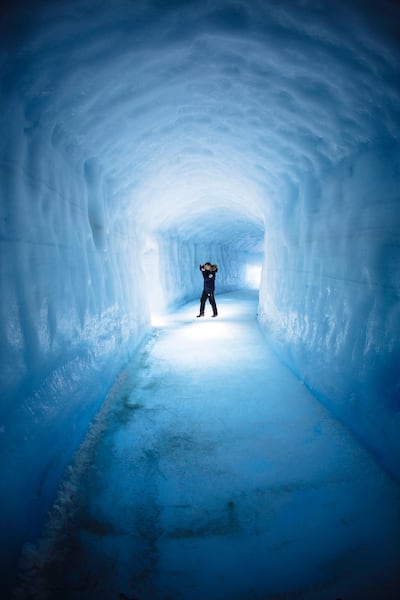It’s a long way down, and when you’re about to descend inside a volcano, it’s entirely reasonable to be a little bit apprehensive about what awaits.
At the top, there are views out across the mossy lava fields that cake south-western Iceland. It has been a bracing three-kilometre hike across them to reach the entrance to Þrihnukagigur and, once there, a rather strange elevator awaits.
The previous incarnation was one of those platforms that hardy souls get dangled down on to clean skyscraper windows. The new one is purpose built to slide through the gaps in the rock and enter the magma chamber. It’s a six-minute drop, heading 120 metres down into the guts of the (mercifully dormant) volcano.
If this sounds somewhat unusual, that’s because it is. This is not just the only place in the world where visitors can head inside a volcano, it’s also thought to be the only place where such a hollowed-out volcano exists. That it does is a happy accident. Usually when eruptions happen, either a solid mountain is formed, or the magma seeps away, leading the cone to collapse.
When Þrihnukagigur erupted about 4,500 years ago, the magma seeped away, but did so in a manner that left behind a self-supporting dome shape. It was first explored in 1974, but only opened to the public in 2012. The biggest danger, apparently, is people accidentally dropping things from the elevator.
What lies beneath
On the way down, there are white speckles. "It's elf dust," says the elevator operator. "Although some scientists will claim it's bacterial growth."
There are also sludgy brown streaks that look rather like cake icing. This is the lava from the eruption – it just dried and stayed frozen in time as it was flowing. Some of this has peeled off, exposing the bedrock, which is streaked with the colours of the different elements contained within. The yellows are sulphur, the reds are iron and the greens are copper. The black lines, though, are where the magma shot up, following the path of least resistance.
Once on firm ground, it's extraordinarily daunting. The chamber is far bigger and taller than the Statue of Liberty, and the only way back out is on the contraption that is being slowly winched back to the surface. Lighting has been set up to show off the chamber, and the scale is gasp-inducing. Going for a scramble across the rocky floor leads to darkened alcoves and walls of tuff – rock made from the volcanic ash, which crumbles and powders at the first touch.
Arching my neck upward, it seems to go up forever, and water filtering through the rock sprinkles down in an ethereal cascade of twinkling diamante. It's a steroid injection for even the most jaded explorer's sense of wonder.
The Silfra Fissure
And that’s something that applies to Iceland in general. It is an overwhelmingly weird country, spurred partly by its sparsely populated, remote nature, and perhaps more significantly by its tumultuous geology. It sits on the divide of two continents – with the Eurasian and North American tectonic plates slowly pulling away from each other. This disruption is what causes the volcanoes and geothermal activity that make the country famous. But in recent years, the Icelanders have got inventive, and come up with several unusual ways to show off nature’s freakiness.
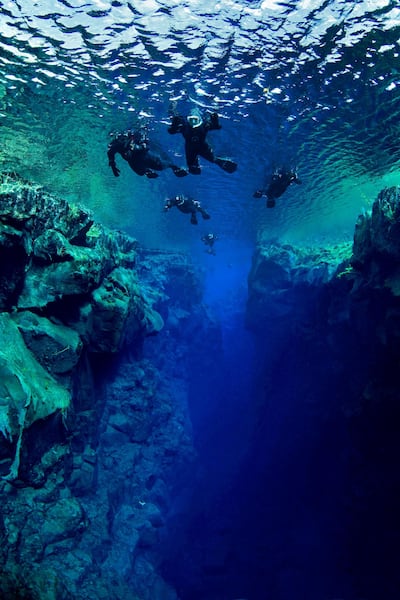
This is certainly the case with that gap between the tectonic plates which, if you’re brave enough, you can go swimming in.
The Silfra Fissure is part of the Þingvellir World Heritage Site, where the rock walls lined up opposite each other give a pretty good shorthand representation of the divorcing continents. It is filled with water that has taken about 30 years to run down from the Langjokull glacier. Unsurprisingly, that water is very cold indeed.Kitting up to get in it, therefore, is a long, laborious process. Special dry suits, with attached boots, then hoods and gloves are required. It looks ridiculous, but is instantly welcome once heading down the steps into water that is only barely above freezing point.
Only the face is left partially exposed for the plunge, but the shock factor comes from the surroundings, rather than the temperature. The water has spent years being filtered through basalt rock. It is about as pure and as clear as it is possible for water to be. There's no sediment, no muddy slush, no run-off and no weeds to obscure the view. It's just a chasm of chunky rock walls either side, and an increasingly deep blue stretching down 63 metres. And that first sighting is a moment of startling, mesmerising bliss. Well, it is up until the open-mouthed proclamations of "oh my word" cause the snorkel to come loose and the spluttering to start.
The current allows snorkellers to float along, face down, like a lazy river in a water park. It glides through an unshakeably peaceful, empty canyon, with caves to peer into for those eager to dive down. There's a reluctance to break the trance by flicking out an arm to steer, and no one quite wants to be the first to shatter the magic by swimming for the shore at the end.

The Silfra Fissure is not Iceland's only home to chillingly cold water, however. Drive along the south coast, past waterfalls and looming cliffs, and you will eventually arrive at Jökulsarlon. It's a lake that is incredibly popular with filmmakers – it played a notable role in Bond film Die Another Day – and several boat trips a day head out on it.
Jökulsarlon lake
But passengers have got to be willing to share. Jokulsarlon is littered with icebergs, which continually break off the glacier beyond, then slowly melt. For the guys steering boats in between the bergs, it means every day is different.
The lake is growing by about 100 metres a year as the glacier slowly retreats, but the ice that breaks off is about 600 years old. It's not exactly going quietly into its dotage, though. As the icebergs melt, chunks slowly break off, unbalancing the berg and sometimes causing it to topple. When it does, the bewitchingly blue ice beneath the water comes to the surface. It looks like a chunk of the ocean, freeze-framed.
The glacier wall is 7km away from where the boats depart, and it’s a game of chicken getting close to it. Chunks could break off at any moment. But what appears to be a solid wall from further away is actually a panorama of weathered, chimney-like spires when sidled up alongside. It’s like an army, marching to war.
The glacier is not able to be tackled by boat, but it's a different story when you have a monster truck with a former life as a Nato mobile rocket launcher to hand. This is what the unimaginatively named Into the Glacier uses to tackle Langjokull.
With eight enormous tyres that can be inflated and deflated by mobile phone, the behemoth slips and slides across the constantly moving ice towards what looks like a big rubber tube. This, it turns out, is the entrance to a Bond villain-esque lair dug deep into the ice.
The company has spent 14 months digging a 550 metre-long ice cave with a diamond-tipped drilling machine. Crunching through on crampons is a marvellous way of beginning to understand how these sprawling glaciers work. Black lines running through the ice betray its age. These lines coincide with the years of volcanic eruptions, with one particularly prominent stripe having settled in 2010 following the notorious plane-grounding Eyjafjallajokull eruption.
The tunnels, lit with LED lighting behind the ice walls for "oohs" and "ahs", go 40 metres down into the packed ice. Here, it's the audio rather than the visuals that are striking. It sounds like a plumbing system in an old house, roaring and glugging away. And that's not far off what it is. Naturally formed, pipe-like channels carry rainwater through the ice towards the bottom of the glacier, where it sloshes around and acts as the bed for the ice to move on.
Again, that awestricken sense of wonder is back. The Earth is an extraordinary place, and Iceland’s collection of weird one-off experiences get you remarkably close to it.
________________________
Read more:
New women-only adventures around the world
Eid Al Fitr: The best holiday travel deals for 2018
The best new hotels in the Middle East
Top 10 wilderness destinations to discover
________________________

